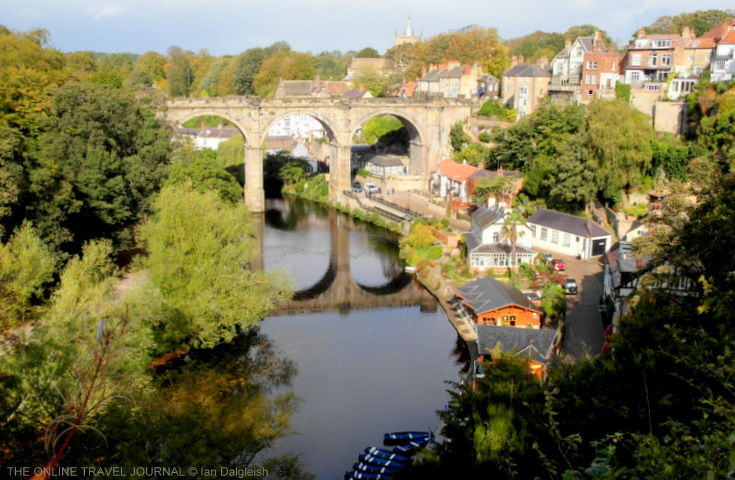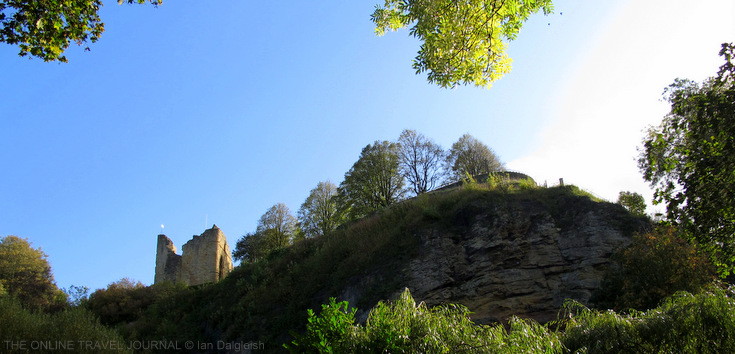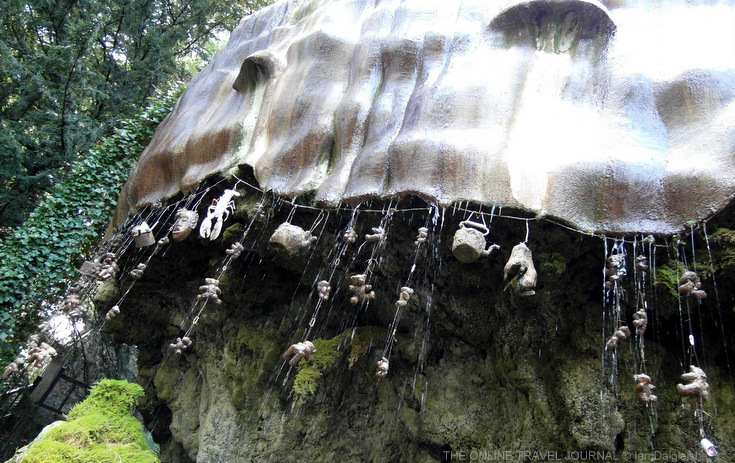A Riverside Walk in Knaresborough
Ever since I first heard Knaresborough roll off the tongue I’ve liked the sound of the place. The Yorkshire market town entered my life as the one time home of my husband’s grandparents and that, in part, was the spur for a visit to this part of Yorkshire visiting half forgotten places from his childhood, completely new to me.
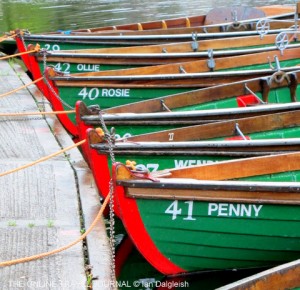 I’d done a little research. For a smallish place Knaresborough has a surprising number of claims to fame, the most arresting being as the birth place the famous Tudor prophetess Mother Shipton and home of the scary sounding Petrifying Well. And then there is that famous chocolate box view over the Nidd Gorge framed from just below the ruined castle on the cliff looking down on the river, row boats moored along its banks, Victorian viaduct in the background. How many jig-saw lovers, I wonder, have pieced the scene together, matching the the reflections of the viaduct in the water, spotting pieces with that particular green of a weeping willow?
I’d done a little research. For a smallish place Knaresborough has a surprising number of claims to fame, the most arresting being as the birth place the famous Tudor prophetess Mother Shipton and home of the scary sounding Petrifying Well. And then there is that famous chocolate box view over the Nidd Gorge framed from just below the ruined castle on the cliff looking down on the river, row boats moored along its banks, Victorian viaduct in the background. How many jig-saw lovers, I wonder, have pieced the scene together, matching the the reflections of the viaduct in the water, spotting pieces with that particular green of a weeping willow?
We spent the night at the Best Western Dower House Hotel and set off on foot the next morning to make a circuit of Knaresborough’s sights, starting just along the Harrogate road, over the bridge at Mother Shipton’s Cave.
The estate was once part of Knaresborough Royal Forest; kings hunted here and, it’s claimed, England’s last wild boar was slain on a spot hereabouts. When local landowner Sir Thomas Slingsby brought the riverside strip back in 1630 he inherited the Dripping Well, already famous for its reputed healing powers. A good Yorkshire man with an eye to profit he lost no time in capitalising on the geological curiosity, fencing it off and charging to sample the magical waters. Hence the park’s claim to be England’s oldest visitor attraction.
“It’s £6.00 each to go in”, said Ian turning to me at the entrance, the unspoken question being do we want to pay that for a stroll along the river bank to see a dank well (it’s the Yorkshire genes). I thought we did, after all this is the place to be seen, in the 18th century London gentry promenaded their afternoons away along these landscaped paths created by Thomas’s great-grandson Henry.
It is a pretty walk along the river bank with remnants of ancient woodland on one side and views of the old Knaresborough rising up out of the Nidd gorge on the other. Knaresborough’s history unfolds, helped by strategically placed information boards bearing the hag like image of Mother Shipton. The striking black and white chequered building (not the first we’ve noticed ) is the old Manor House once the property of the crown - Oliver Cromwell is believed to have stayed in its oak panelled rooms. We passed under the viaduct that brought the railway line and a vital commercial connection to Knaresborough, you can see the castle now and a little further on by the weir a mill latterly converted to desirable apartments. Knaresborough was a linen producing town.
Sir Henry Slingsby’s Long Walk ends in a flight of steps, at the top a boggy patch where the water that feeds the famous well emerges from its mile long, mineral gathering journey through the porous rock below – not, it has to be said, looking very special. A few more steps round to the front of the cliff are needed to see why folk in more superstitious times past found this place spooky. From the overhanging skull like buttress hang a curtain of of objects turned to stone. Sticks and leaves were “stricken” in the Middle Ages, teddy bears are popular subjects for the treatment now, taking about 3 – 5 months to petrify. Famous people have left items to be immortalized in stone, Agatha Christie a handbag, film star cowboy, John Wayne a hat. Of the current crop I liked the lobster.
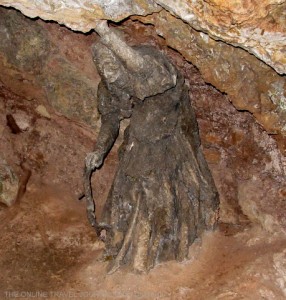 Nearby is the wishing well, there are rules to be followed. I don’t believe in this sort of thing; the magical powers of the water can all be explained by science – right?
Nearby is the wishing well, there are rules to be followed. I don’t believe in this sort of thing; the magical powers of the water can all be explained by science – right?
I made a wish – just in case.
Next a peek in the cave where legend has it Ursula Sontheil (Mother Shipton) was born during a terrific thunder storm. She was prolific in her predictions foretelling the death of several monarchs, the Fire of London, invasion by the Spanish Armada, the coming of iron ships, flight…. A character I don’t doubt, but I think I’ll take the prophecies with a healthy dose of skepticism, particularly as many only came to light some time after her death.
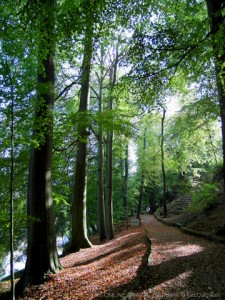 Leaving the park through an avenue of tall, straight beech trees, leaves sparkled with rain drops from a recent shower. Hats off to Sir Henry Slingsby for his foresight in planting them .
Leaving the park through an avenue of tall, straight beech trees, leaves sparkled with rain drops from a recent shower. Hats off to Sir Henry Slingsby for his foresight in planting them .
Back on the Knaresbororough side there’s a choice of staying with the river (on a more clement day hiring a boat would have been the thing to do I could see myself reclining elegantly in the stern of a row boat) or to climb up through the Berbra gardens to the castle and town. There is little left of the castle. The King’s Tower dating from Norman times is the most intact bit, looking like a cut-away diagram. In England’s Civil War Knaresborough was a Royalist town holding out against the Parliamentarians for three weeks before capitulating. I assumed the castle had been raised to prevent re-tenanting. Only in part it seems; the thrifty, practical townsfolk did the rest taking a good part of the castle stonework for their own buildings.
Too many cars clutter the streets to call Knaresborough picturesque but it has a quaint air, perhaps it’s all the tea shops. Rain set in discouraging a leisurely browse. We hurried on past the old market cross, 18th century road and bridge builder Blind Jack Metcalf (born here) looked down from his namesake pub.
One thing is for sure, there’s no lack of inspiration for a pub name in Knaresborough.
Knaresborough Round Up The Name From the Knaresborough Online site I discovered that while borough is well documented coming from the Anglo Saxon "burgh" meaning a fortified settlement. While the "Knare" part, it's thought, could derive from the name of a chieftain or from "knar" meaning a rocky outcrop. Market day is Wednesday The Great Knaresborough Bed Race To witness a bit of fun you might like to visit in June when the Bed Race takes place. Decorated beds parade through the streets then stripped of adornment carrying one passenger take part in a race that includes a crossing of the River Nidd. Good for a Break by Train With the railway station central to the town and all attractions within the riverside circuit Knaresborough makes a very manageable destination for a short break See www.nationalrail.co.uk for train times and connections. Web Sites For history, information and listings see tidily put together www.knaresborough.co.uk Information & opening times for the castle can be found here. There are tours of the dungeons and a museum - they weren't open at the time of our visit but sound interesting. For information about Mother Shipton's see www.mothershipton.co.uk There's a museum with a display of petrified objects.
Tell us what you think about visiting geological curiosities like the Petrifying Well. Do they evoke a sense of wonder?
Back to Knaresborough